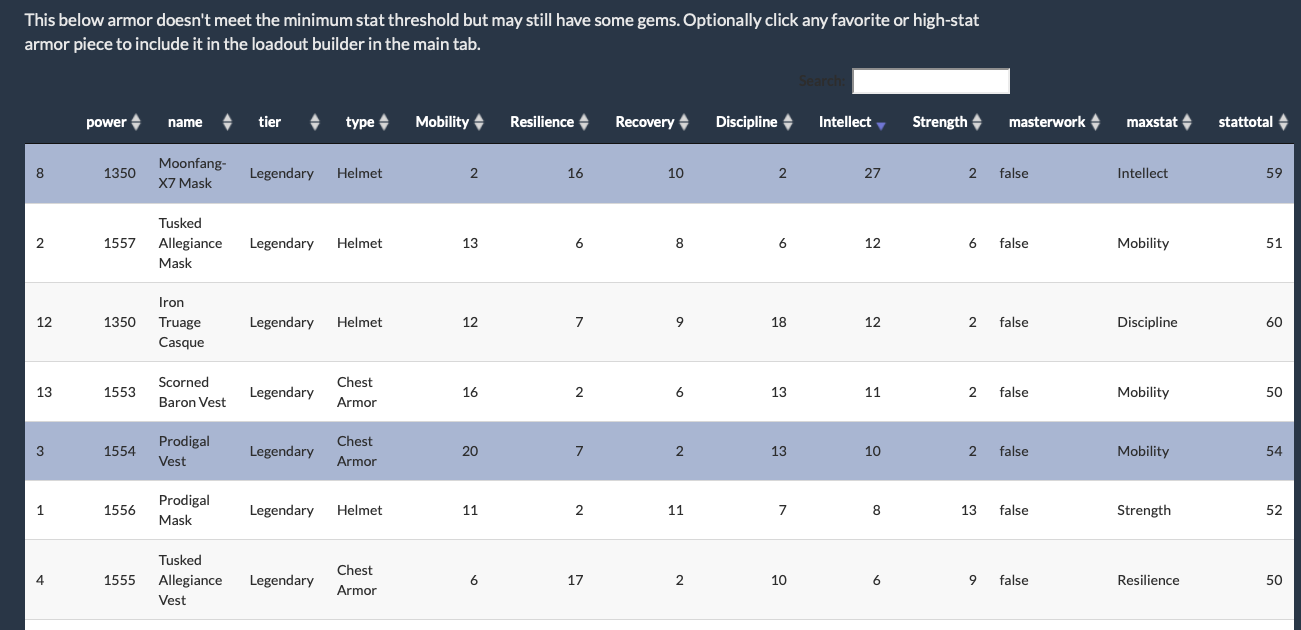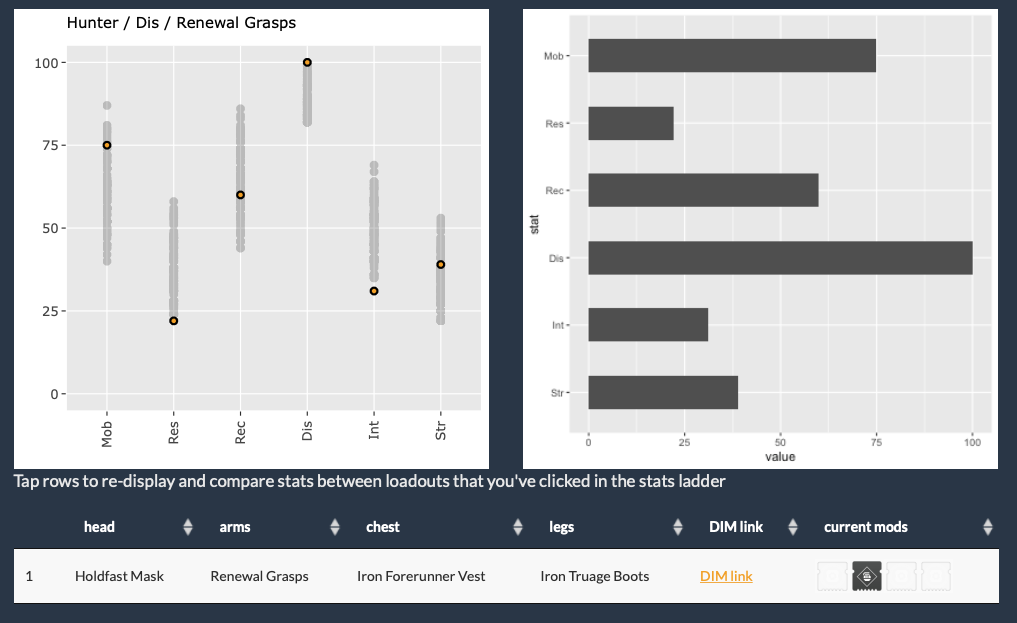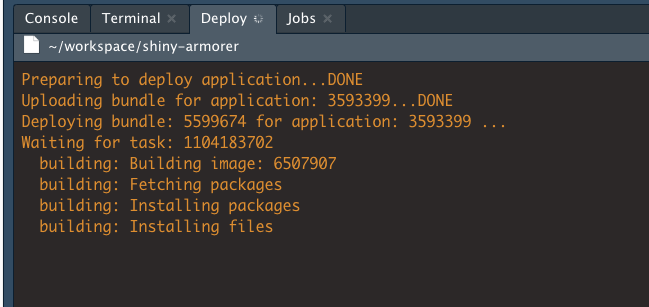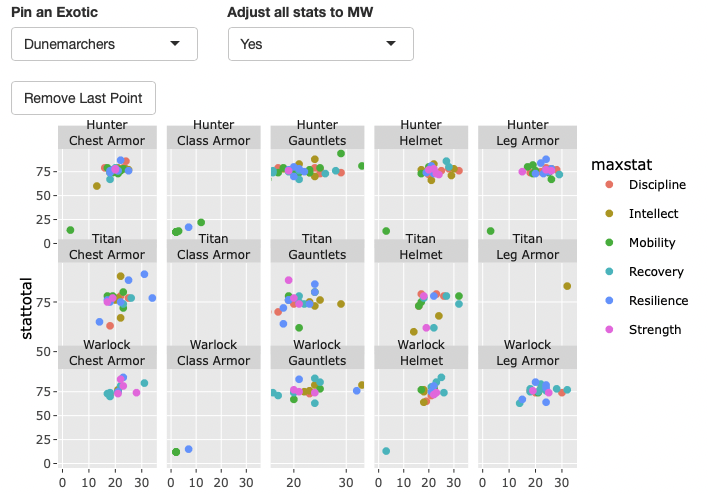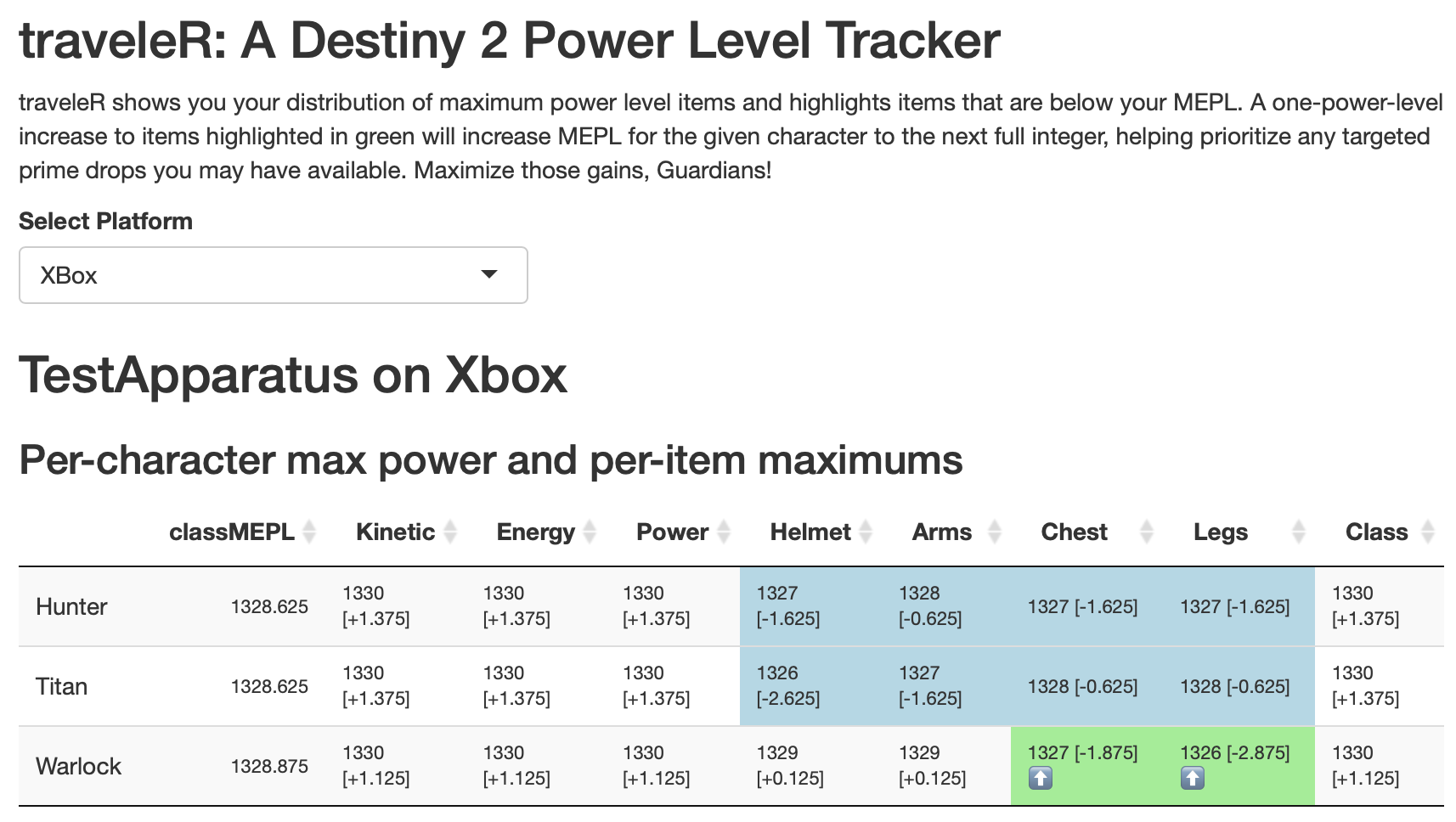Just learned of {httr2} (https://github.com/r-lib/httr2), a rewrite of R’s httr package, and am excited to try it out! The pipeable API looks like a nicely improved way to build complex requests.
I’ve had a nice afternoon working on my hobby R/Shiny project, a loadout finder for the game Destiny 2. These improvements make it a lot more flexible and informative: It can now optionally include armor that would otherwise be filtered out of configurations by the minimum stat threshold, and it will show current mods used in displayed loadouts.
I’m sure it poses some benefits for systematic parsing (and I’m certainly much more comfortable working in R and markdown, for what it’s worth) but Jupyter’s reliance on json for its file format seems like a big disadvantage for readability and portability.
This revision of ArmoreR is really turning into something I’m happy with and proud of. I’ve learned so much since the very first iteration of this about a year ago. It’s really fun and rewarding to come back to it with a bunch of new expertise and make it much better in all ways, including a new approach to dealing with such a large amount of information.
I spent a bunch of the weekend beginning a redesign of my ArmoreR project, which aims to be a Destiny 2 armor stats profiler built in R and Shiny. A year on from when I began it, I have a much better understanding of how a Shiny app works, and have also incorporated a proper, working oauth2 workflow into this revision (incorporating the things I figured out for my power level tracker). It’s really, really satisfying to be rebuilding it with all the things I’ve learned. I think the application is going to be so much better and less complicated than the first iteration. I still have a ways to go, and am happy with just how much I have transformed it with a year of learning and practice on other things.
Last fall I wrote a bit about a Destiny 2 power level tracking tool I built using R. I’ve now converted it to a full-on Shiny app and solved some issues with the oauth2 flow that stumped me in my intermittent tinkering with it. I’m super satisfied to have been able to get this to work! Now that I have the authentication process figured out, I’m eager to also convert my armor profiling tool to use it. Look out!
You can check it out here: traveleR
Today I made improvements to some R code in my Destiny 2 hobby-coding-verse after learning how to much more cleanly deal with nested lists. I had previously used a solution using map() to apply a selector to each item in the list, but this was clunky, hard to remember, and became really hard to read with several levels of a nested list.
The far better solution is the unnest_auto function from {tidyr}, which I came upon when tinkering with the last.fm API data recently. Once I understood how it works, it’s so easy and satisfying! The key is to first make a named tibble.
> tibble(my_tibble = instanced)
# A tibble: 906 × 1
my_tibble
<named list>
1 <named list [10]>
2 <named list [10]>
3 <named list [10]>
4 <named list [10]>
5 <named list [12]>
6 <named list [10]>
7 <named list [10]>
8 <named list [10]>
9 <named list [9]>
10 <named list [9]>
# … with 896 more rowsThat nice tibble can be operated on by unnest_auto():
> tibble(my_tibble = instanced) %>% unnest_auto(my_tibble) %>%
select(itemLevel, breakerType)
Using `unnest_wider(my_tibble)`; elements have 8 names in common
# A tibble: 906 × 2
itemLevel breakerType
<int> <int>
1 132 NA
2 133 NA
3 133 NA
4 132 NA
5 133 3
6 132 NA
7 133 NA
8 133 NA
9 0 NA
10 0 NA
# … with 896 more rows(I selected just a couple of columns for readability there; if you don’t do that, you’ll receive all fields at the current list level, including additional nested lists if they exist). After figuring this out, I realized that I also needed to keep the names of each list element, because they constitute a unique ID for the element returned from the API query, and I banged my head a bit on trying to do that as a part of the unnest operation, before I backed up, recentered on the outcome I wanted to produce, and realized I could do it really cleanly using mutate()! The final code looks like this:
> tibble(my_tibble = instanced) %>% unnest_auto(my_tibble) %>%
select(itemLevel, breakerType) %>% mutate(id = names(instanced))
Using `unnest_wider(my_tibble)`; elements have 8 names in common
# A tibble: 906 × 3
itemLevel breakerType id
<int> <int> <chr>
1 132 NA 6917529338105913753
2 133 NA 6917529550016812142
3 133 NA 6917529281178546429
4 132 NA 6917529231127188610
5 133 3 6917529301504642848
6 132 NA 6917529234625200021
7 133 NA 6917529193313832065
8 133 NA 6917529182955737017
9 0 NA 6917529417667489181
10 0 NA 6917529490520758715
# … with 896 more rowsThe D2 API returns a ton of nested lists, so this simplified, accessible and effective tool is 100% getting a featured spot in my toolbox.
Recent chat around micro.blog about enabling an “on this day” plugin prompted me to put together the shortcode below. Unlike sophisticated hugo configurations, mine is just updated by a cron job, so I can render it statically, without any javascript, and it’s always current to the day, even if I haven’t posted that day.
I call this shortcode from my /now page:
Posts on this day ({{ now.Format "Jan 2" }}):
<ul>
{{ range (where .Site.RegularPages "Section" "in" (slice "post" "note")) }}
{{ if eq .Date.YearDay now.YearDay}}
<li><a href="{{ .Permalink }}">{{ .Date.Format "2006-01-02"}} / {{ .Title }}</a>
{{end}}
{{ else }}
<li>... no entries ...
{{ end }}
</ul>Hugo: render hooks and partial for displaying images
Markdown render hooks allow for adding customization to the default markdown to html rendering in hugo. When placed in _default/_markup/render-image.html, this example overrides the standard rendering of images from markdown to include a call to Glightbox.
<a href="{{ .Destination | safeURL }}" class="glightbox" data-gallery="{{ .Page.Permalink }}">
<img src="{{ .Destination | safeURL }}" alt="{{ .Text }}" style="max-height: 720px" />
</a>This grabs the page’s permalink for the data-gallery property.
For photos specified in a post’s yaml frontmatter, I call a partial in my article template, photos.html:
{{ range .Params.photo }}
<a href="{{ replace .value " " "" }}" class="glightbox"
data-gallery="{{ replace .value " " "" }}">
<img src="{{ replace .value " " "" }}" alt="{{ .alt }} "
style="max-height: 720px;" />
</a>
{{ end }}Both of these assign the data-gallery property in order to avoid overlapping galleries on index or other pages with multiple posts. One future improvement to try is building a shortcode to replace the partial, so that the gallery ID or other properties can be customized at call time.
